#unifactor
Text
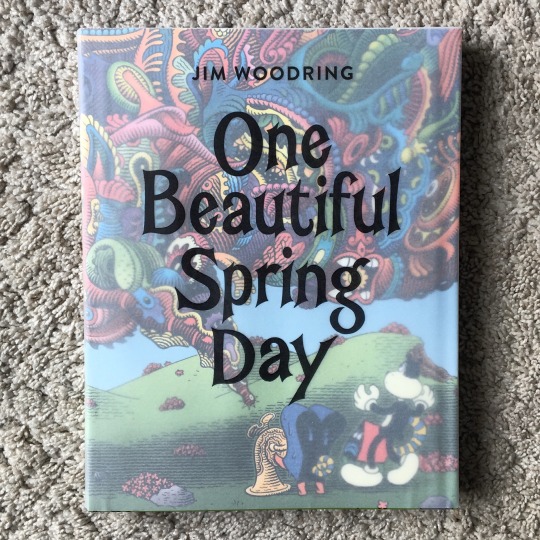
Jim Woodring: One Beautiful Spring Day (2022)
#jim woodring#comics#graphic novel#fantagraphics books#wordless#pantomime#unifactor#metaphysical#jiva#frank#manhog
1 note
·
View note
Text
Lum the Forever, Kazuo Yamazaki, 1986


Lum the Forever is a lot of things, an internally reflexive thematic conclusion to a franchise. Like the more iconic Beautiful Dreamer (in popular memory -- LtF is much more preoccupied with its inherited pop cultural iconography) an anxiety of Urusei Yatsura’s perpetual existence as a meme and a franchise in which its cast may never grow or change from experience is interrogated, but in Yamazaki’s film the philosophical scope is narrowed to fears of sickness, ageing and death. Lum is losing her abilities, and at the same time she is becoming aware of a world larger, more wonderful complex frightening than the unifactor of the episodic comedy scenario (“I didn’t know there were so many sounds.”) She is growing and in growth she becomes weaker, in growth she is pushed outside of visibility in her community which is not growing. Life is vast and in life strength fails her.

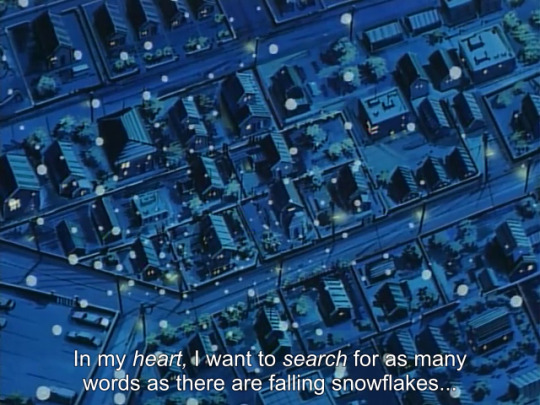

Lum regains her strength in introspection. She becomes a writer, she becomes an observer. She lives out a new childhood constructed out of the present moment. She reawakens to a world that has shattered and cracked in her absence, never the same, back to normal.
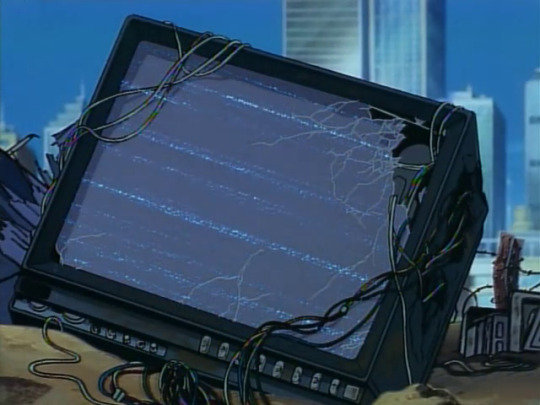
This short reflection was originally posted to my now defunct substack August 6, 2020. A lifetime ago, it feels.
-Helen Sarah C.
27 notes
·
View notes
Video
vimeo
MSHR - Wave Guide Edifice from MSHR on Vimeo.
Music video for Wave Guide Edifice from the Album Phased Trance Constructions by MSHR. Released on Unifactor in 2018.
2 notes
·
View notes
Text

Stated very plainly by the master of the Unifactor, Manhog deserves what he gets.
0 notes
Photo

The process of creating comics or manga is an exciting and challenging journey that involves more than just drawing lines and blobs on paper. To create a truly meaningful work, you need to explore the time, imagination, pain, contradiction, and emotions it takes to bring the characters and story to life. There are two fundamental motivations for making comics or manga. The first is the need to "express", to release something that has been seen, felt or experienced and that urgently needs to be released from within. The second motivation is to explore a slice of reality that no one else has seen before, an idea or a story that can make a difference and that is important to share with the world. If your motivation is to "express yourself", you must be prepared for the challenge that this implies. Making comics isn't like having a rock band; it's a task that requires time, dedication, and patience to bring your characters to life and tell a meaningful story. Also, to make comics or manga you need to use THE TIME; the memories, desires, present, alternate, of real or fictitious beings. In other words, you need to explore the time and life of the characters in order to give depth to the story. The "unifactor" is another important part of the process of creating comics or manga. It refers to the vast prairies of the lived (non-neurotic) imagination, which have been colonized by capitalism and the obsession with consumption. It's important to bring back the pathos, pain, and contradiction in the story, and avoid losing focus on things that don't matter, like video games and unnecessary entertainment. In short, creating comics or manga is a complex process that requires exploring imagination, time, pain, and contradiction to create a work that is meaningful and impactful in the world. It is important to remember that this is not simply a matter of drawing lines and blots, but of bringing characters to life and telling stories that resonate with the audience. #comic #comics #art #drawing #illustration #manga #mangaka #manwha #webcomic #indie #comicstrip #makecomics #artist #igcomics #digitalart #igcomicfamily #instacomics #indiecomic #scifi #comicbookartist https://www.instagram.com/p/CowIoRmMRt_/?igshid=NGJjMDIxMWI=
#comic#comics#art#drawing#illustration#manga#mangaka#manwha#webcomic#indie#comicstrip#makecomics#artist#igcomics#digitalart#igcomicfamily#instacomics#indiecomic#scifi#comicbookartist
1 note
·
View note
Audio
no love for ned airs on wlur at 8pm tonight. it's followed by a repeat of last week's show at 10pm which makes four solid hours we can spend together! as always, last week's show is below and available to stream whenever you'd like!
no love for ned on wlur – august 12th, 2022 from 8-10pm
artist // track // album // label
lawrence // don't lose sight // hotel tv // beautiful mind
st. john's wort // my kind of love // my kind of love ep // people places
elizabeth // sweet connection // sweet connection digital single // antifragile
air waves // wait // the dance // fire
party pest // happy man // happy man 7" // psychic hysteria
208l containers // sunburnt in brisbane // a night at the mirage // rough skies
lifeguard // i know i know // crowd can talk cassette // born yesterday
bibione // summer hit // bibione 7" ep // stoned to death
kiwi jr. // the sound of music // chopper // sub pop
buffet lunch featuring me lost me // the power of rocks // the power of rocks // upset! the rhythm
bonnie "prince" billy featuring david berman // outsider // outsider digital single // drag city
nina nastasia // blind as batsies // riderless horse // temporary residence
jess ribeiro // in love with this place // in love with this place digital single // remote control
burnign plastic blues band // compulsion // peculiar refractions in the fullness of time cassette // unifactor
kali malone // living torch ii // living torch // portraits grm
codona // que faser // codona two // ecm
keefe jackson, oscar jan hoogland, joshua abrams and mikel patrick avery // epistrophy // these things happen // astral spirits
jackie mclean // revillot // it's time // blue note
domi louna and j.d. beck featuring anderson .paak, busta rhymes and snoop dogg // pilot // not tight // apeshit
maxo featuring pink siifu // forty-eight // even god has a sense of humor // def jam
katalyst, adrian younge and ali shaheed muhammad // daybreak // jid013 // jazz is dead
beyoncé // cuff it // renaissance // parkwood
u.s. girls // so typically now // so typically now digital single // 4ad
legends of country // if that's what it takes // anything but country // talk about country
northern portrait // long live tonight // the swiss army // matinée
penguin no yuuutsu // ochiru // aimaimu cassette // gerpfast
lisasinson // no sé muy bien // un año de cambios // elefant
the slow summits // time's on your side // time's on your side digital single // hundreds and thousands
1 note
·
View note
Text
The Cute and Horrifying World of Jim Woodring
In “One Beautiful Spring Day,” the cartoonist takes his orders from the imaginary world that he creates.

Where do you get your ideas?” is a question that most authors dread. The cartoonist Jim Woodring has a simple answer, although it’s likely to elicit more and stranger questions. Woodring has published four book-length comics and an enormous collection of short stories that follow the distressing adventures of his hero, a woodland creature called Frank, who lives in a dreamlike world filled with deserts, forests, minareted castles, hot-air balloons, a devil, and the occasional cylindrical chicken. Woodring calls this place the Unifactor, and says that it tells him what to draw, and how. The Unifactor allows him to draw and write about it only in a certain way; if he tries to go against its instructions, the Unifactor may interfere or abandon him. The process is painful, but its results are unique—the Frank stories are both utterly foreign and purely lucid, a set of gnomic parables that always end in a puff of irony or ambiguity. They leave behind not broad moral lessons but the harsh laws and uncrossable boundaries that apply only in a fictional world unlike any other.
READ MORE
1 note
·
View note
Text
Page-Turner: The Cute and Horrifying World of Jim Woodring
In “One Beautiful Spring Day,” the cartoonist takes his orders from the imaginary world that he creates.
— By Sam Thielman | August 9, 2022

“I don’t trust my mind for everyday thinking,” Woodring writes.Photograph by RL Rejmaniack/Courtesy Fantagraphics Books
“Where do you get your ideas?” is a question that most authors dread. The cartoonist Jim Woodring has a simple answer, although it’s likely to elicit more and stranger questions. Woodring has published four book-length comics and an enormous collection of short stories that follow the distressing adventures of his hero, a woodland creature called Frank, who lives in a dreamlike world filled with deserts, forests, minareted castles, hot-air balloons, a devil, and the occasional cylindrical chicken. Woodring calls this place the Unifactor, and says that it tells him what to draw, and how. The Unifactor allows him to draw and write about it only in a certain way; if he tries to go against its instructions, the Unifactor may interfere or abandon him. The process is painful, but its results are unique—the Frank stories are both utterly foreign and purely lucid, a set of gnomic parables that always end in a puff of irony or ambiguity. They leave behind not broad moral lessons but the harsh laws and uncrossable boundaries that apply only in a fictional world unlike any other.
In Woodring’s huge new graphic novel, “One Beautiful Spring Day,” each panel is drawn in a style that looks like an eccentric woodcut. The figures are outlined in clean, straight, black lines, but Woodring has hatched in the shadows with a series of perfectly parallel, shallow waves that vary in thickness. Their amplitude, however, never changes—it’s the frequency at which the Unifactor seems to vibrate. The effect is something like Doré meets Dalí: stories of pure dream logic rendered as reverently as an etching of the infant Christ. Every surface emits a kind of otherworldly specificity, both resoundingly weird and as reassuringly solid as a drafting table.
Frank himself could easily be a habitué of an old Max Fleischer cartoon—a cousin to Bimbo the Dog, perhaps—with his rubbery black limbs, white gloves and shoes, and cute, bestial, species-nonspecific features. In personality, Frank is generally childlike, but without parents to keep him in check. If there is a button, he will push it. If there is a vase, he will break it, sometimes by accident, but not always. If something looks good to eat, Frank will at least try a bite. He first appeared in 1991, in the second and final issue of Mark Landman’s anthology comic “Buzz,” alongside strips by the caricaturist Drew Friedman and by Charles Burns, the author of “Black Hole” (and, briefly, an MTV darling). Landman asked Woodring to produce “a comic that looks normal, but isn’t.” Woodring drew “Frank and Manhog,” a silly, queasy story based on a corny joke: Frank, finding part of a worm in his apple, is so devastated by the experience that he builds a statue of the half-eaten creature.
Woodring seems to enjoy baiting the reader’s suspicion that he is compelled against his will to draw Frank, and this heightens the corresponding sense that the Unifactor somehow exists, whether or not it defies laws of physics and logic. In one especially gruesome tale, Woodring writes narrative captions under the panels—an unusual tic in the mostly wordless Frank stories—but, before the action has gone on for more than a few pages, the narrator finds the events of the story so upsetting that he decides to talk about something else. “I wonder how many grains of rice there are in a fifty pound sack,” he muses, as Frank’s occasional nemesis, Manhog, whom Woodring has said is based on his father, flays his leg and daubs silver paint on the exposed gore.
Frank himself often seems confused by the caprice of the world around him, which frequently punishes him for breaking its rules. Frank has two pets, Pushpaw and Pupshaw, who look like the fraternal-twin offspring of a dachshund and a footstool. Although they tend to understand the laws of the Unifactor a little better than their master, the three of them have endured a number of bewilderingly violent escapades, often involving flying, symmetrical creatures who seem to be made out of a sort of flexible pottery. Woodring, who admires Hinduism, calls these beings “jivas,” jiva being the Sanskrit word for “living substance,” or soul, in Hinduism and Jainism; they often grow more complex as Frank beholds them, developing organic-looking flanges and frills and bulges until they overwhelm and chase him. But they are also a part of Frank and his neighbors—occasionally, Frank himself will hit his head so hard that one of them flies out of the wound, like Daffy Duck’s ghost might in a Looney Tunes short. Only Frank and Manhog seem truly disturbed by the jivas and their kin. (Some Unifactor denizens seem to be jivas themselves; others contain them; still others look distantly related to them.) Everyone else, including Frank’s pets, has some sort of commerce with them, often including strange and beautifully inventive magical powers.
In structure, Frank’s escapades have a sort of mathematical precision. The status quo must always be reëstablished at the end of each story, and Frank must never learn anything. (Occasionally, Frank dies.) “One Beautiful Spring Day” is four hundred pages long, a series of narrative nesting dolls that begins and ends on more or less the same note, but with a symphony of uncanny menace in between.
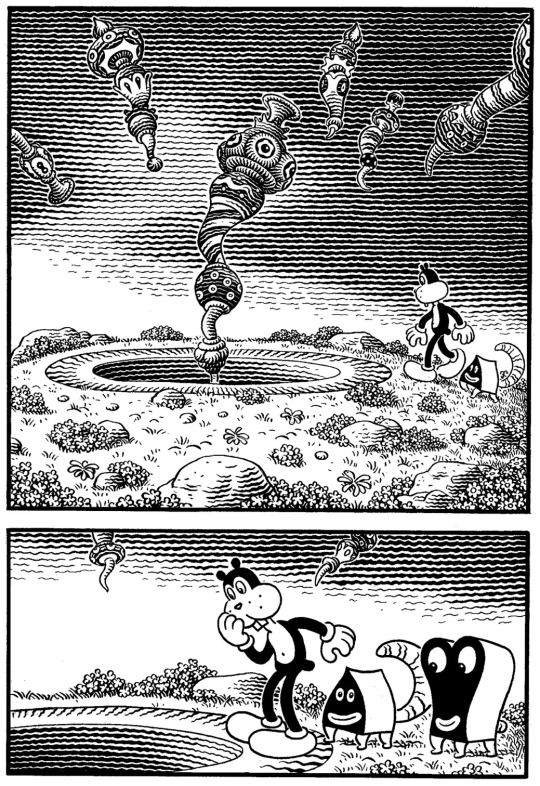
Art work by Jim Woodring /Courtesy Fantagraphics Books
Since he was three or four years old, Woodring has hallucinated. “I’d be lying in bed and I’d see large, silent, rotating faces hovering over the foot of my bed, faces that were very cartoony, actually,” he told The Comics Journal, in 1993. “Big, horrible, grimacing, deeply-lined faces with their mouths open, yelling at me silently, moving their mouths rapidly.” By his own estimation, Woodring has painted one hallucination in particular hundreds of times: “a large, bulbous, rubbery-looking froglike creature,” as he describes it in the introduction to “Jim,” a collection of his early work. The creature first appeared before him in an art-history lecture during his not-quite-a-semester at Glendale Community College. Now it adorns the covers of a book of his charcoal drawings, “Seeing Things,” and several issues of his comics. “I don’t trust my mind for everyday thinking,” Woodring writes, in the introduction, “but I am convinced that it has one very great function, which is to eventually make me aware of astounding things.”
For as long as there has been art, artists have sought to depict astounding things and thus purge them from their troubled minds. Goya expressed his fear of madness through scenes of paranoia, terror, and supernatural persecution in the Black Paintings. In the lifelong depressive Walker Percy’s novel “Lancelot,” about a depressed murderer confined to a psychiatric hospital, the plot advances as his depression recedes, allowing him to recall his crimes. The Frank corpus, for its part, coheres in one hapless creature’s attempts to amuse himself in between horrifying encounters with monsters that are both unknowable and the building blocks of the world around him.
Woodring was the opposite of an overnight success. His family was poor, and his twenties were lost to alcoholism and occasional homelessness. By the early nineteen-eighties, though, his life stabilized: he had met his wife, Mary, and he was drawing storyboards for Ruby-Spears animation, where he worked on “Turbo Teen,” about a kid who turns into a car, and a “Mr. T.” cartoon. It was dreck, but down-at-heel genius was everywhere at Ruby-Spears: among his co-workers were Jack Kirby, who had brought “The Fantastic Four” and “Captain America” to life; Alex Toth, the prolific cartoonist, Hanna-Barbera designer, and Space Ghost creator; and the influential superhero artist Gil Kane, who introduced Woodring to the comic-book editor Gary Groth. The audience for Woodring’s work grew slowly—throughout the nineteen-nineties, his name appeared on paycheck gigs like the “Alien” and “Jabba the Hutt” comics—but his early devotees included Francis Ford Coppola, who wrote the introduction to “The Frank Book” in 1995, and the fellow-cartoonist (and New Yorker cover artist) Ivan Brunetti. “I look at your stuff and I get really depressed because I could never, ever, in a million trillion years do what you do with a brush and paper,” Brunetti wrote, in a fan letter published in Woodring’s “autojournal” comic book (also called “Jim”) that same year. (Woodring uses not a brush but a pen—sometimes a very large pen.)
Though a late bloomer, Woodring managed to avoid a dead-end career in corporate comics, and, by 2010, he’d reached wide acclaim, hadn’t had to write anything set on Tatooine or Dagobah in a while, and had published his first stand-alone book, a hundred-page Frank fable called “Weathercraft.” It was a longer, more complex story—Manhog is tortured by witches who extract his soul remotely, and he learns the true nature of the universe before being kicked back into his place by a satanic creature called the Whim—but it was classic Frank, which is to say, pure Unifactor, and it made several end-of-year lists.
In Woodring’s next book, “Congress of the Animals” (the first of three incorporated into “One Beautiful Spring Day”), Frank’s house falls down; he hires a builder to fix it, but can’t pay him, so he goes to work at a factory, where he must pour a slurry made of crushed-up birds into a machine that looks like a printing press—and then, every day, as he leaves work, he has to hand over his payment to the angry builder. (You could be forgiven for seeing some parallels to Woodring’s time at Ruby-Spears in these pages.) Frank escapes, and, at the end, meets Fran, apparently the female of his species. He has perky ears; hers are droopy and prehensile. He has a rounded tail; hers is pointy. He has chubby cheeks; she has a slightly heart-shaped face. (It’s remarkable how economically Woodring communicates nonhuman femininity; the panel where Fran first appears is viscerally shocking.) Fran changes Frank’s life for the better; they wake up in bed together, and seem to live happily ever after. Until this book, Frank’s pleasures had been carefully circumscribed—a delicious meal, or a ride on a dangerous contraption—but in “Congress of the Animals,” Woodring gave his avatar lasting happiness.
That simply wouldn’t do. In the lidless eye of the Unifactor, it seemed, Woodring was in error. He had planned to draw a graphic novel about Pushpaw and Pupshaw, called “Poochytown,” but he couldn’t—his muse had forsaken him, he said, and now he was obligated to draw “Fran,” in which Frank and Fran break up, and Fran is revealed to be something like a goddess. In this installment, she can now take many forms, not just that of a female Frank. She is more than a person but also, somehow, less—yet another vector of the terrifying and hallucinatory world around Frank, and not even a reliable companion, like Frank’s pets. When Woodring got around to drawing “Poochytown,” he redrew six pages of panels from “Congress of the Animals” in his careful style, with one disorienting difference: on the sixth page of “Poochytown,” Pupshaw opens a different box than the one he picked two books earlier. Woodring also fixed small flaws in parts of the copied pages, in an effort to get the vibe even closer to perfect—as pleasing to the Unifactor as possible. (It was, he told me in 2015, “a pain in the ass, ” but these were “the terms of my employment.”)

Art work by Jim Woodring /Courtesy Fantagraphics Books
For “One Beautiful Spring Day,” Woodring has added a fourth narrative layer and a new character, a travelling magician. The new book replaces and expands on “Congress of the Animals,” “Fran,” and “Poochytown,” adding exactly a hundred new pages of material. Whereas “The Frank Book” simply reprinted old stories, “One Beautiful Spring Day” weaves its component books together into a single dizzying tale: Frank’s momentary happiness with Fran is now one of several picaresque episodes, including an incident from “Poochytown” in which he happens across a steering wheel and a pedal that control the rotation of the planet. (He immediately wrecks it.)
Its repairs complete, Frank’s world—Woodring’s world, the Unifactor—remains ambiguous, ominous, and, more often than not, cute. But its ambiguity is now within the parameters that Woodring’s muse has set for him. Fran is gone by the end of the story. The magician makes most of the story disappear, as part of one of his tricks, then moves on, presumably to do the same to another citizen of the Unifactor. Like most of Woodring’s work, this twist is both charmingly eccentric and very sad. Woodring has become a monumental artist, but Frank can never change. He must always be the same odd little person who was horrified over the half-a-worm in his apple, three decades ago. “One Beautiful Spring Day” contains some of the most beautiful pages that Woodring has ever drawn, and some of the images, like the magician’s giant foot stepping into one vast double-page spread, are indelible. But the Unifactor has decreed that Frank himself may not grow at all. ♦
0 notes
Text


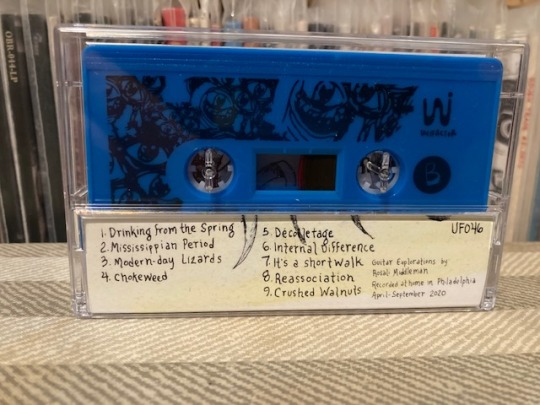
12 May 2022: Chokeweed, Rosali. (Unifactor, 2021)
Accompanying my previous post, here is the cassette of experimental guitar instrumentals by Rosali that I bought alongside her debut album Out of Love when she opened for Destroyer at Chicago’s Thalia Hall last month.
The top photo is the front cover, and I’ve rotated it because I seem to have photographed it upside down! You then see the spine, and last the back of the cassette package revealing credit details.
Next is the inside of the insert.

Last we see the cassette by itself. Both sides have the same design. The blue shell indicates this as a second pressing; the first run of Chokeweed was on red cassettes. And, fortunately, there is a download included so I can listen to it without being tied to a tape deck.
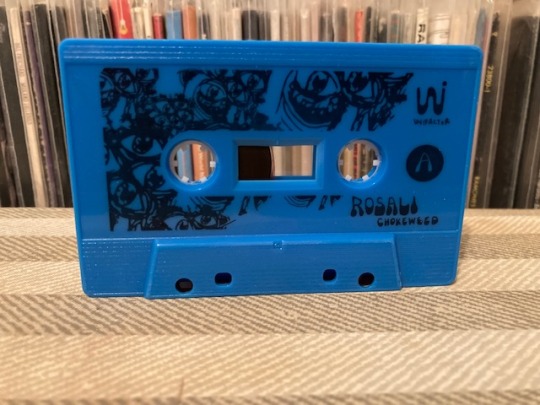
0 notes
Photo
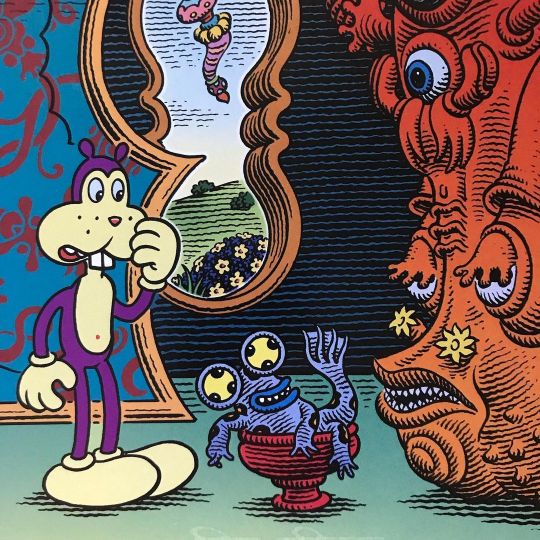
The Museum of Love & Mystery. - Jim Woodring #PressPop #Frank #Unifactor https://www.instagram.com/p/Cc5U4S9L7cr/?igshid=NGJjMDIxMWI=
13 notes
·
View notes
Photo
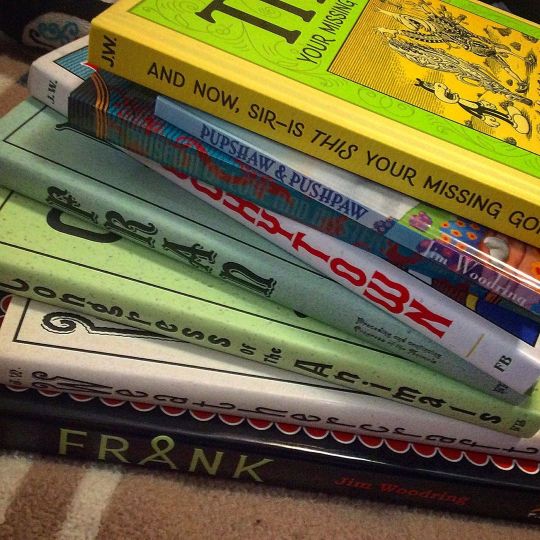
Frank stack . . . . . . #frank #frankcomics #jimwoodring #books #comics #readmorecomics #fantagraphics #fantagraphicsbooks #unifactor @jimwoodringcartoonist @fantagraphics #cartoonartist #cartoonist #cartoon #weird #silentcomics #alternativecomics https://www.instagram.com/p/CEAOTfKBp6q/?igshid=pmhi00fcdrit
#frank#frankcomics#jimwoodring#books#comics#readmorecomics#fantagraphics#fantagraphicsbooks#unifactor#cartoonartist#cartoonist#cartoon#weird#silentcomics#alternativecomics
2 notes
·
View notes
Text
High Aura’d — If I’m Walking in the Dark, I’m Whispering (Unifactor)

If I'm walking in the Dark, I'm whispering by High aura'd
The two long tracks on this EP take shape out of a dark miasma of tone, a swelling, tactile baseline hum that surrounds you like a soft squishy padded room; you feel you could poke at the edges with your finger and feel the boundary of perception give a little. Out of that soup of possibility, recognizable instruments emerge—primarily guitar in the first one, guitar and piano in the second—though really, the sounds almost all come from guitars, even the tumbling, loose-skinned tom drumming that paces “If I’m Walking in the Dark.” Elsewhere guitar (and pedals) make sounds like a pipe organ, like a string orchestra, like the thrum of live power wires.
This is the second High Aura’d release this year for Cleveland-based composer John Kolodij, and he also released the really lovely Gemini Sisters record early in 2018. Like that Gemini Sisters recording, If I’m Walking builds songs out of watery, indefinite washes of sound, sudden brightly focused elements and oblique references to traditional folk and blues. The main difference is that Gemini Twins uses heavily processed vocals as a route to unearthly aura; these cuts rely almost entirely on guitar.
As in Daniel Bachman’s The Morning Star, American primitive style picking flits and filters through a hall of mirrors, sounding like a dream of the blues, a half-corroded memory of folk music, as it threads through glowing unreal landscapes. As with the Bachman, the real world occasional makes a cameo appearance. A hint of sirens keens in the side B, “I’m Whispering” though miles and miles away.
This is not a record you can rush through. On side A, you wait four minutes and 36 seconds for the first unaltered strum, but it is well worth it. The guitar tone is hauntingly clear and lucid, like Hisato Higuchi. With time, it gains weight and friction and dissonance, a rasp of conflict in two overlayered melodic lines. And then, it pulls in on itself, folding back into a sea of drone, an inchoate tide of tone lapping up around guitar sounds and slowing covering it over.
“I’m Whispering,” the one with piano, lets high notes ice through the gloom. They ring luminously amid smoke banks of soft amorphous hum. The effect is not quite classical, but nowhere near folk either, serene and simple like Max Richter’s piano compositions. In the last third of the piece, a breezy, bucolic guitar enters in, changing the piece entirely and making it more accessible. Yet even as the flurry of folk-picked melody makes you comfortable, a strange echoing drone brings on a chill. The music is lovely, but not quite what it seems.
Jennifer Kelly
#high aura'd#if i'm walking in the dark I'm whispering#unifactor#jennifer kelly#albumreview#dusted magazine#john kolodij#american primitive#drone#guitar#piano
2 notes
·
View notes
Text
High Aura’d - If I’m Walking In The Dark, I’m Whispering

High Aura’d latest album ‘If I’m Walking In The Dark, I’m Whispering’ is out now on Unifactor.
Purchase Cassette: High Aura’d - If I’m Walking In The Dark, I’m Whispering
#high aura'd#unifactor#ambient#drone#experimental electronic music#cassette#cassette culture#cassette blog#joyful union#joyful union cassette blog#cleveland
1 note
·
View note
Photo
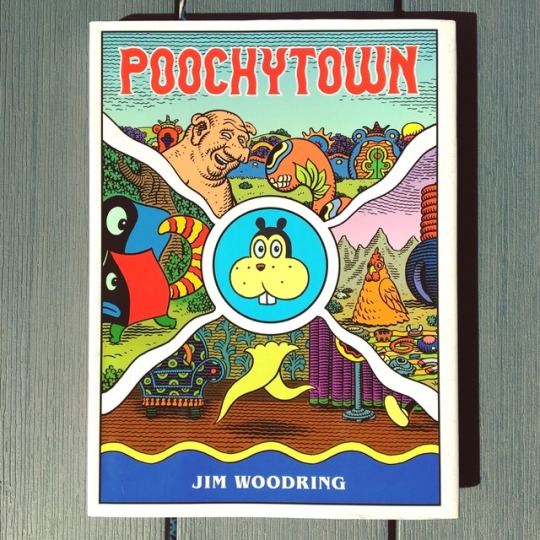
Jim Woodring: Poochytown (2018)
10 notes
·
View notes
Photo

Brett Naucke.
The Back of The Garden, 2018.
Unifactor Tapes.
177 notes
·
View notes
Photo

New Hard Folk - Self-titled
Unifactor Tapes
2018
28 notes
·
View notes